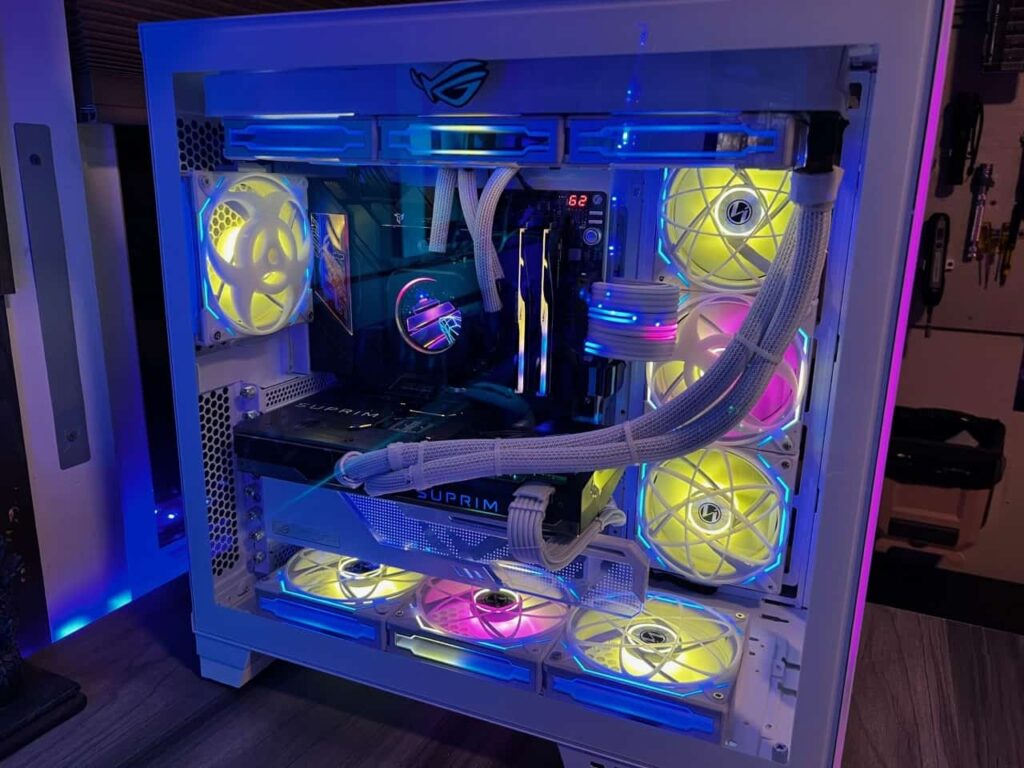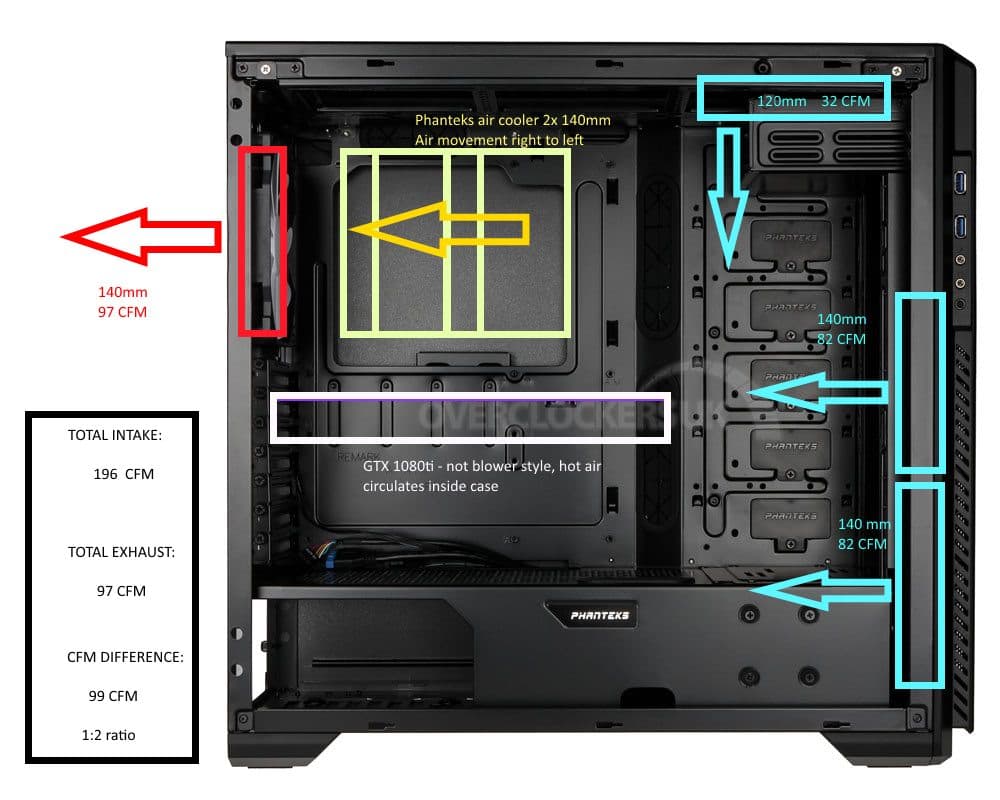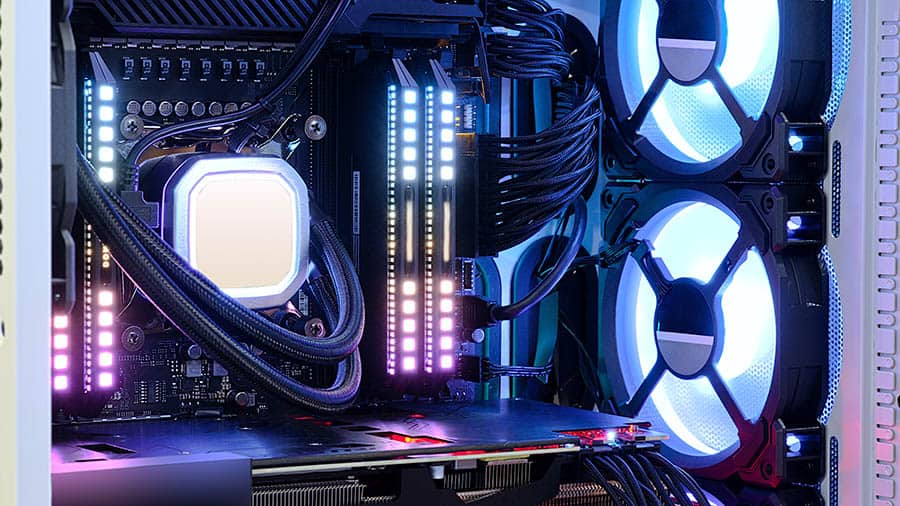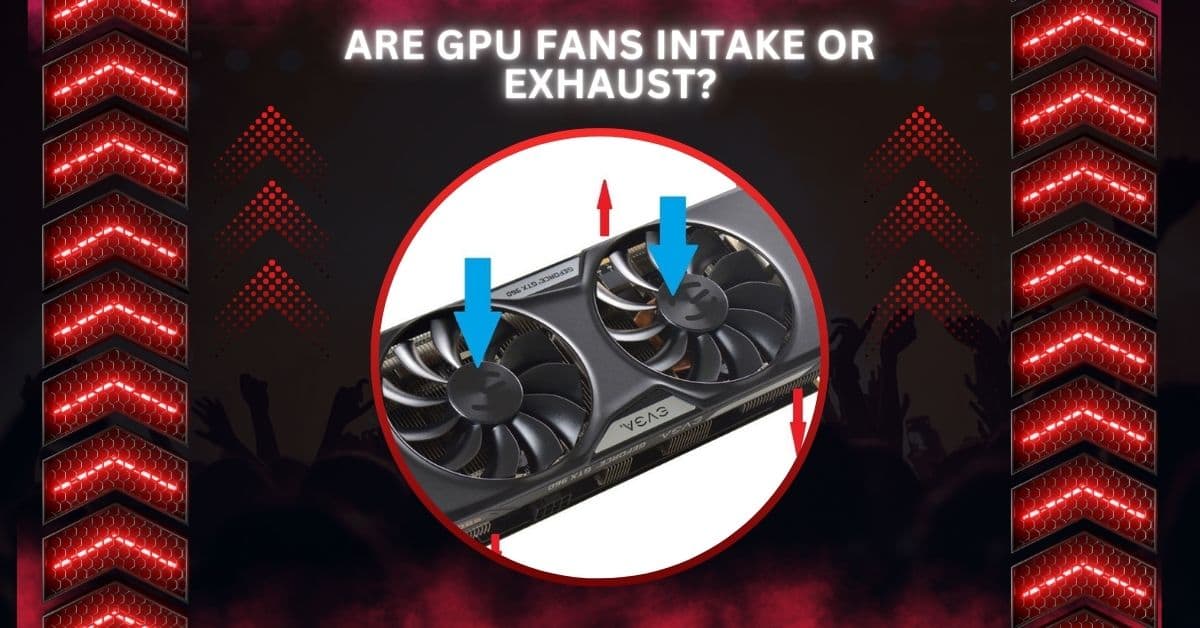Graphics cards generate significant heat, making proper cooling essential for performance and longevity.
Whether GPU fans act as intake or exhaust depends on the card’s design. Most GPUs have intake fans that pull cool air in, but some blower-style fans expel hot air as exhaust. Understanding your GPU’s cooling system is key for optimal performance.
Let’s explore this topic further to better understand how GPU fans work and how to manage airflow in your system for optimal cooling.
What Are GPU Fans?
GPU fans are crucial components that help maintain the ideal temperature for your graphics processing unit (GPU).
These fans are usually small and attached directly to the graphics card. They dissipate heat generated by the GPU, which can be substantial during gaming or other graphically intensive tasks.
There are two primary types of GPU fans:
- Axial Fans: These are the most common types. They push air downwards onto the GPU’s heatsink, cooling the components.
- Blower-Style Fans: These are less common but serve a specific function by directing air sideways and out of the case.
The specific fan design will influence whether the GPU fans function more as intake or exhaust.
How Does GPU Cooling Work?

Before we delve into whether GPU fans act as intake or exhaust, it’s crucial to understand how GPU cooling works.
Most GPUs come with heatsinks, metal fins attached to the GPU that dissipate heat. The GPU fans work with the heatsink, moving air over the metal fins to cool down the components. The fan’s direction, placement, and design dictate air circulation.
Are GPU Fans Intake or Exhaust?
Typically, most GPU fans act as intake. These fans draw cooler air from within the PC case and push it across the GPU’s heatsink, helping to reduce the GPU’s temperature.
However, exhaust fans also exist, primarily in blower-style cooling designs. These fans work by pulling hot air away from the GPU and expelling it from the case. This cooling method is commonly seen in reference or Founders Edition GPUs and certain compact builds.
Must Read: Is 80 Degrees Celsius Hot For A GPU? – How To Keep It Cool!
Axial vs. Blower-Style Fans
Understanding the difference between axial and blower-style fans is key to determining whether a GPU fan is acting as intake or exhaust:
- Axial Fans: These fans push air directly onto the heatsink. They are commonly found in open-air GPUs, where the air is dispersed into the case. Axial fans generally operate as intake fans, drawing cooler air from within the case.
- Blower-Style Fans: In contrast, blower-style fans push hot air sideways and out through a vent in the case. These fans typically function as exhaust fans, removing heat from the GPU and expelling it outside the case.
What Is the Impact of Airflow Direction?
The direction of airflow plays a significant role in determining the effectiveness of your GPU cooling system. Let’s explore how both intake and exhaust airflow impacts the overall performance of your GPU and system.
1. Intake Fans
Intake fans are common in GPUs designed with axial cooling systems. These fans pull cooler air into the GPU, providing better thermal management for the graphics card.
However, the intake process can increase the overall temperature within the case, which might affect other components like the CPU and motherboard.
2. Exhaust Fans
Exhaust fans, especially in blower-style cooling systems, are designed to expel hot air from the GPU and direct it outside the case.
This helps maintain cooler temperatures inside the case and prevent heat buildup in small form-factor systems.
Must Read: Is Warzone CPU Or GPU Intensive – Key Insights For Gamers!
Pros and Cons of Intake and Exhaust GPU Fans

Both intake and exhaust GPU fans have advantages and disadvantages depending on your PC’s cooling needs.
1. Pros of Intake Fans:
- Efficient Cooling: Intake fans are excellent at cooling down the GPU quickly, especially in high-performance gaming or rendering tasks.
- Balanced Airflow: These fans create a steady stream of cool air, which improves overall performance.
2. Cons of Intake Fans:
- Dust Accumulation: Since intake fans pull air from inside the case, they can also pull in dust, increasing maintenance.
- Potentially Increased Case Temperature: The cool air pulled by intake fans can raise the overall temperature of the system.
3. Pros of Exhaust Fans:
- Keeps Case Cooler: By expelling hot air out of the case, exhaust fans help maintain lower internal temperatures, benefiting the overall system.
- Prevents Heat Buildup: Especially useful in compact builds or small cases, exhaust fans ensure that hot air is efficiently expelled.
Also Read: Is Cod CPU Or GPU Intensive – A Deep Dive Into Game Demand
4. Cons of Exhaust Fans:
- Less Cooling for GPU: While it cools the case, the airflow over the GPU might not be as effective, potentially causing higher GPU temperatures.
- Noisier Operation: Exhaust fans, particularly in blower-style GPUs, can be noisier as they work to push hot air out.
How to Check Whether Your GPU Fans Are Intake or Exhaust?
It’s relatively simple to figure out whether your GPU fans are functioning as intake or exhaust by observing the airflow:
- Intake Fans: If the air is blown towards the graphics card or heatsink, the fans work as intake. You can often feel a cool breeze if you hold your hand near the fan while the system runs.
- Exhaust Fans: If the air is being pushed out of the back of the GPU and expelled from the case, then the fans are functioning as exhaust.
Optimizing Your PC’s Airflow

Optimize the airflow within your case to maximize your GPU cooling. A balanced combination of intake and exhaust fans ensures your GPU remains cool while preventing heat pockets from developing in your PC.
1. Tips for Optimizing GPU Fan Usage:
- Fan Placement: Ensure that intake fans are at the front or bottom of the case, while exhaust fans should be at the rear or top.
- Dust Management: Regularly clean the fans and filters to prevent dust buildup that can impede airflow.
- Custom Fan Curves: Use software like MSI Afterburner to adjust fan speeds based on GPU temperatures, ensuring an optimal balance between performance and noise.
Also Read: Why Is Valorant Using So Much GPU – Key Reasons And Fixes!
Does GPU Fan Direction Matter?
Yes, the direction of GPU fans can significantly impact your system’s overall temperature and performance.
Proper airflow management is crucial in keeping the GPU and other components running efficiently. In most cases, axial fans acting as intake provide the best cooling for the GPU itself, while blower-style fans acting as exhaust is better for managing overall case temperatures.
FAQs
1. Are PSU fans intake or exhaust?
PSU fans are typically exhaust fans. They expel hot air generated by the power supply, keeping the PSU and other components cool inside the case.
2. Are CPU fans intake or exhaust?
Most CPU fans are intake, pulling cool air onto the CPU heatsink to cool it down. Some setups include exhaust fans near the CPU for airflow.
3. Does a GPU fan exhaust or intake?
Most GPU fans act as intake, pulling cool air in to cool the heatsink. Blower-style GPUs, however, exhaust hot air out of the case.
4. Are fans below GPU intake or exhaust?
Fans below the GPU are usually intake fans. They pull cool air from the bottom of the case, helping keep the GPU cool during operation.
5. Do GPU fans push air in or out?
Most GPU fans push air in towards the GPU, cooling the components. Blower-style fans push hot air out through the back of the card.
6. Do GPU fans always run?
No, GPU fans don’t always run. They usually start spinning when the GPU reaches a certain temperature to prevent overheating during heavy use.
7. Do GPU fans cool the PC?
GPU fans cool the GPU, but they also contribute to cooling the overall system by reducing the heat generated by the graphics card.
8. Fans under GPU
Fans located under the GPU are generally intake fans. They help pull cool air into the system, ensuring better cooling for the GPU and components.
9. What are GPU fans for?
GPU fans are designed to cool the graphics card by moving air over the heatsink. This prevents the GPU from overheating during gaming or heavy tasks.
10. Should intake fans be faster than exhaust?
Intake fans should generally be faster than exhaust to ensure proper airflow and cooling. This helps maintain positive air pressure and lower system temperatures.
Conclusion
In conclusion, GPU fans typically function as intake, pulling cooler air over the heatsink, while blower-style fans act as exhaust, expelling hot air from the case. Proper airflow management is crucial for maintaining GPU performance and overall system cooling. Regular maintenance and optimal fan placement enhance efficiency.
